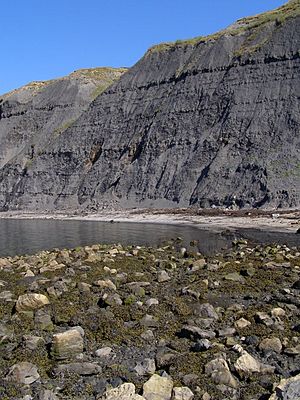Kimmeridge clay facts for kids
Quick facts for kids Kimmeridge ClayStratigraphic range: Kimmeridgian-Tithonian |
|
|---|---|

Grey cliffs of Upper Kimmeridge Clay above the beach at Egmont Bight
|
|
| Type | Geological formation |
| Unit of | Ancholme Group |
| Lithology | |
| Primary | Mudstone |
| Other | Siltstone, Sandstone, Conglomerate |
| Location | |
| Region | England (surface) North Sea (subsurface) |
| Country | England |
| Type section | |
| Named for | Kimmeridge Bay |
The Kimmeridge clay formation is a sedimentary deposit of fossiliferous marine clay and mudstones. It is of Upper Jurassic age, and occurs in Europe. It gives its name to a stage in the Upper Jurassic called the Kimmeridgian, lasting from 157.3–152.1 million years ago.
Kimmeridge clay is perhaps the most economically important unit of rocks in the whole of Europe, because it is the major source for oil fields in the North Sea.
The clay is named after the village of Kimmeridge on the Dorset coast of England, where it is well exposed and forms part of the Jurassic Coast World Heritage Site. It exists across England, in a band stretching from Dorset in the south-west, north-east to East Anglia and Hull. The River Humber Bridge's foundations are in the Kimmeridge Clay deposits under the Humber estuary.
The fossil fauna of the Kimmeridge Clay includes a reptile fauna of turtles, crocodiles, dinosaurs, plesiosaurs, pliosaurs and ichthyosaurs, as well as many invertebrate species such as Gryphaea.
Kimmeridge Clay is of great economic importance, being the major source rock for oil fields in the North Sea hydrocarbon province. A Kimmeridge Oil Shale Project (KOSP) has been pursued by the UK based oil and shale gas exploration company Cuadrilla Resources.
Images for kids
See also
 In Spanish: Arcilla de Kimmeridge para niños
In Spanish: Arcilla de Kimmeridge para niños
















